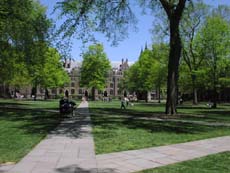index
Mundane but discontinuous places
Discontinuous places appear in our everyday lives. Expansive sprawl or city may offer dispersed networks of locations that work as grammatically unified places instead of separated places. This depends on what kinds of links and actions stretch over the networks. Universities are an obvious example of a discontinuous place. A large hospital complex is another. These institutions may spread across separated locations yet act as a single place for some actions and rituals. More informally, a group of teenagers might bring various discontinuous locations into rituals of group cohesion and membership, creating a unified but discontinuous ceremonial place. Social grammar can bring spatially disconnected areas into place unity. Within the larger unity will be sub-places -- the issue of overall unity depends on just what actions and norms and relations are acted out, at what kinds of internal and external borders. As people and actions circulate within it, a university or a hospital is more likely to be a unified place is a corporation with separated locations and internal flows. There are no sharp thresholds where place unity suddenly appears or disappears, but there are clear cases at either end of the scale.

